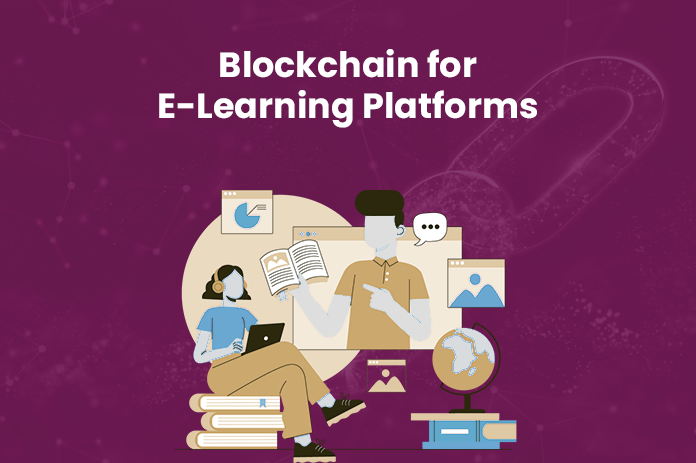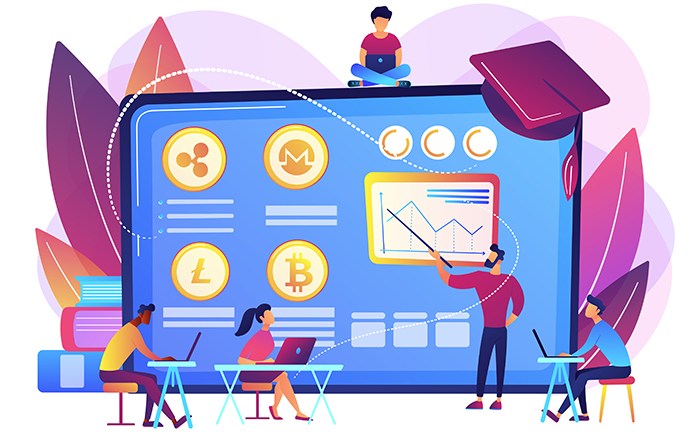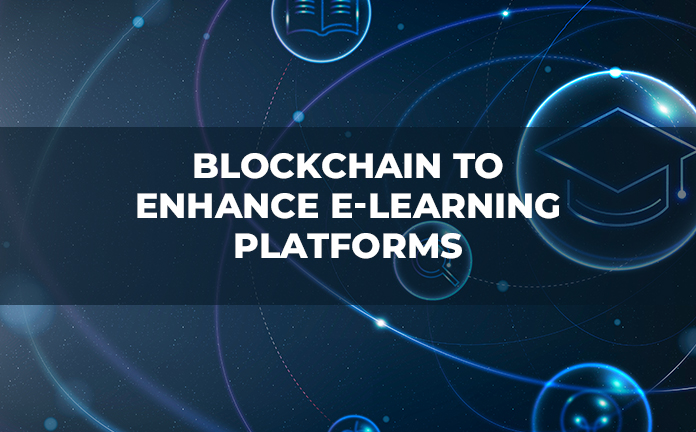Innovative Uses of Blockchain to Enhance E-Learning Platforms

Blockchain, the technology behind Bitcoin, is quickly gaining popularity in various industries. However, it is being most widely applied in the education sector. In this blog post, we’ll take a look at some innovative ways that blockchain is being applied to e-learning platforms.
Why blockchain technology is the Best for e-learning platform?
Blockchain technology has revolutionized many aspects of the modern world, and EdTech is no exception.
As a distributed ledger system, blockchain offers unparalleled transparency and security to e-learning platforms. It provides the platform with an immutable record of the interactions between the students and instructors, ensuring authenticity and accuracy of the content.
In addition, blockchain technology allows for secure payments, with no need for a third party or middleman. This makes it an ideal choice for e-learning platforms, as it ensures that the transactions are secure and the payments are made quickly and accurately.
Moreover, blockchain also offers a number of advantages for EdTech, such as data analytics and a reliable platform for transactions. Data analytics allows EdTech platforms to gain insights into student behavior and track progress. This way, they can tailor the courses to fit the students’ individual needs and provide personalized learning experiences.
Additionally, blockchain technology also offers a secure platform for transactions, as the transactions are recorded and stored on a distributed ledger. This ensures that all transactions are secure, as any changes made to the data are immediately detected and corrected.
So, Blockchain technology is an ideal choice for e-learning platforms, as it offers unparalleled transparency, security, and authenticity.
It also provides a reliable platform for transactions, as well as data analytics to help EdTech platforms tailor courses to individual student needs.
All of these advantages make blockchain technology the best choice for e-learning platforms.
How Blockchain can enhance the e-learning platform?

Blockchain technology has the potential to revolutionize the e-learning platform in many ways. To begin with, it can bring about transparency in assessments, making it difficult for any third party to manipulate scores or academic records.
Through a decentralized ledger, the evaluation and certification process can be made secure and verifiable. This would also make it easier to conduct auto verification of users without the involvement of third parties.
Furthermore, blockchain can also introduce Non-Fungible Tokens (NFTs) in the e-learning platform. This would help in providing a secure and reliable way to store educational credentials and certificates, making them easy to access and verify.
Additionally, it would also be possible to create smart contracts that can be used to automate the tasks related to assessment or payment processing. This would not only save a lot of time and resources but also make the whole process more secure and transparent.
All in all, blockchain technology can significantly enhance the e-learning platform in many ways.
How can you implement blockchain to build e-learning platform?
Blockchain technology can be used to build an effective e-learning platform. To start with, Non-Fungible Tokens (NFTs) can be used to create digital certificates and diplomas at the end of a course. This will help to create an atmosphere of trust and security for the online platform.
Beside that blockchain-enabled user authentication and identity management can be used to ensure the safety and security of student data, while also protecting against malicious attacks.
Moreover, blockchain technology can also be used to integrate courses and assessments, which will make the platform more efficient and easier to use.
Finally, blockchain can be used to enable direct interactions between teachers and students, which will facilitate better communication between the two.
All of these implementations will help to create a secure and reliable e-learning platform.
How Blockchain can increase your e-learning platform value?
 Blockchain technology has the potential to revolutionize e-learning platforms. Integrating blockchain with existing e-learning platforms can increase its value and provide a more secure, efficient, and transparent learning experience.
Blockchain technology has the potential to revolutionize e-learning platforms. Integrating blockchain with existing e-learning platforms can increase its value and provide a more secure, efficient, and transparent learning experience.
Next.js, a popular open source JavaScript framework, can be used as the front-end technology to build the user interface. Back-end technology such as web3.js can be used to integrate the blockchain with the e-learning platform. This integration will enable users to securely access and store data on the blockchain and conduct transactions with ease.
In addition, blockchain can provide enhanced data security and privacy for e-learning platforms. By encrypting user data and making it immutable, blockchain ensures data privacy and integrity.
It also enables organizations to store data on multiple nodes, providing increased protection from malicious attacks.
Furthermore, blockchain technology can enable organizations to automate processes, track data, and store records. This will reduce overhead costs and administrative burdens, as well as minimize errors and discrepancies.
So, Integrating blockchain with e-learning platforms can result in increased value and improved user experience.
By using Next.js as the front-end technology and web3.js as the back-end technology to integrate with the blockchain network, organizations can gain access to secure and reliable data storage, improved data privacy, automated processes, and reduced overhead costs.
All of these benefits make blockchain an attractive solution for improving the functionality of e-learning platforms.
What value would blockchain offer versus with the traditional relational DB?
Blockchain technology has been gaining traction due to its potential to revolutionize the way data is stored, managed, and secured. Compared to traditional relational database systems, blockchain technology offers significant advantages in terms of transparency, security, and authentication.
Depending on whether the blockchain is private or public, the level of transparency, security, and authentication can be adjusted to meet the needs of the organization and its stakeholders.
On the transparency side, blockchain technology provides a shared, immutable ledger that is accessible to all stakeholders. This ledger is maintained by a distributed network of computers, providing a single source of truth for all stakeholders to verify and trust.
This transparency is beneficial for organizations that need to share data with multiple parties, as it reduces the need for intermediaries who can compromise the security and accuracy of the data.
From a security point of view, blockchain technology offers an unprecedented level of protection. Its distributed nature makes it virtually impossible for one actor to alter the data without the consensus of the entire network.
Furthermore, the cryptographic algorithms used in the consensus process provide an additional layer of security to ensure that data is not tampered with. This makes blockchain technology highly secure, even when compared to traditional database systems that are prone to hacking and data corruption.
Blockchain technology also offers pure authentication capabilities. This means that only authorized users can view or modify data, without the need for an intermediary. This ensures that only authenticated users are able to access the data, and that the data is not altered by an unauthorized user.
This pure authentication is especially beneficial for organizations that need to protect sensitive data from unauthorized access.
So, Blockchain offers many advantages over traditional relational database systems when it comes to transparency, security, and authentication.
Depending on whether the blockchain is private or public, organizations can adjust the level of transparency, security, and authentication to fit their specific needs.
What language would be best for a perfect EdTech solutions?
When it comes to developing a perfect EdTech solutions, choosing the right language is essential. Solidity is the ideal language for a back-end approach due to its high level of flexibility and scalability. It is the language used for writing smart contracts on the Ethereum blockchain, which provides an excellent foundation for building secure and reliable applications.
Solidity is also specifically designed to enable developers to quickly and easily create smart contracts with complex features.
Web3Js is a great choice for the front-end of an EdTech solution. Web3Js is a JavaScript library that enables developers to interact with any Ethereum-based blockchain. It allows them to access, create, and use smart contracts with ease.
Additionally, Web3Js is compatible with other blockchain networks such as Polygon and Binance Smart Chain, which provides the necessary flexibility to create a comprehensive EdTech solution.
Finally, Ethereum, Polygon, and Binance Smart Chain all offer the necessary features for developing a high-performance EdTech solution.
Ethereum provides a reliable base layer for smart contracts and a decentralized platform for applications.
Polygon offers a secure, low-cost Layer 2 solution for scaling Ethereum and Binance Smart Chain provides a highly efficient, low-cost blockchain for developing applications.
With these three blockchains, developers can create a secure, reliable, and cost-effective EdTech solution.
Some examples of successful e-learning platform using Blockchain
The use of blockchain technology for e-learning platforms is becoming more widespread, and there are a number of examples of successful implementations.
- Gilgamesh :- This is a platform that allows users to read and write reviews of books. They also have an authentication system that utilizes blockchain to verify the validity of reviews and comments.
- Blockcerts :- This is another successful open source platform that allows students to store and share their credentials in a secure and verifiable manner.
- APPII :- APPII is a great example, as they offer a secure platform that allows employers to verify qualifications and certifications online.
- ODEM :- This is a blockchain-based platform that connects students, educators, and employers with each other, providing a marketplace for educational services.
- Sony Global Education :- It is another example of a successful blockchain-based e-learning platform. This platform provides students with a secure and private way to access educational materials, allowing them to access learning resources from any device.
Finally, the University of Nicosia has developed a blockchain-based platform for its students, allowing them to securely store and share their educational records with employers. They also offer master’s in Blockchain courses.
Overall, blockchain technology is becoming an increasingly popular option for e-learning platforms. These examples demonstrate the security and reliability that blockchain technology can provide, and how it can be effectively implement to authenticate records and credentials.
With more companies and organizations recognizing the potential of blockchain-based e-learning platforms, it is likely that more successful implementations will continue to emerge in the coming years.
Conclusion
Technology is driving education. More than ever before, technology has introduced new opportunities, such as e-learning. In this blog, we provide an overview of how blockchain can apply in the education industry.
If you want to build a smart e-learning platform using blockchain technology, please stop by our site and email us. We’d love to hear from you.
